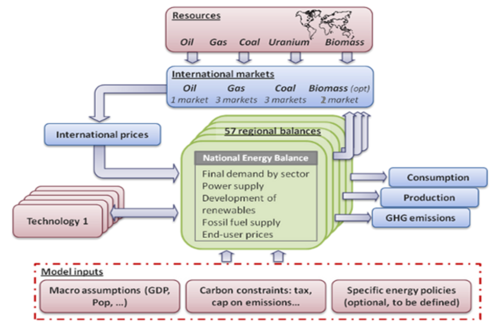Model concept, solver and details - POLES
| Corresponding documentation | |
|---|---|
| Previous versions | |
| Model information | |
| Model link | |
| Institution | JRC - Joint Research Centre - European Commission (EC-JRC), Belgium, http://ec.europa.eu/jrc/en/. |
| Solution concept | Partial equilibrium (price elastic demand) |
| Solution method | SimulationRecursive simulation |
| Anticipation | Myopic |
POLES (Prospective Outlook on Long-term Energy Systems) is a global recursive dynamic simulation model of the energy system allowing to simulate a wide range of energy policies, be they on the demand side or on the supply sector. It displays a high regional resolution and sectoral representation, and provide endogenous simulation of all steps of the energy system by vector and sector: final energy demand, transformation (including power generation), trade, primary supply, international and final user prices. Additional modules allow covering GHG emissions from industrial sources, and agriculture and land-use emissions are derived from a soft linkage with the GLOBIOM model. The economic decisions (investment and utilisation rate) are based on a myopic anticipation of future costs and constaints for the agent, considering vintage, resource potentials and other interia. The model is developed with the Vensim software.
- The model describes full energy balances for 57 countries and regions covering the World, and primary supply for 80 countries / regions, as well as energy commodities trade and trade routes.
- It operates on a yearly time step and benefits from frequently updated databases, allowing it to capture the most recent developments of energy markets in various countries / regions.
The figure below gives a schematic view of the POLES model. The red boxes are the main assumptions, calibration and scenario settings; the green box represents the energy balance resolution by country / region and the blue boxes represent the trade and key outputs (demand, supply, emissions).
General Scheme of POLES
Key input assumptions are population and growth of GDP per capita. The economic activity is then derived by the model at sectoral level, depending on economic growth and energy prices: economic sector value added, passengers and goods mobility, building stocks, etc..
Other critical assumptions are energy resources by type and localisation.
